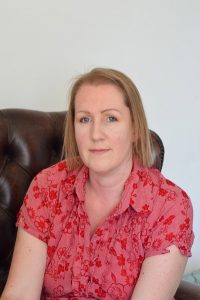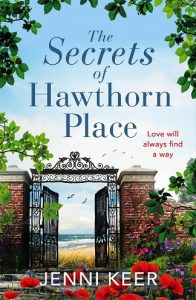Where Do You Get Your Ideas From?
 Jenni Keer
Jenni Keer
As an author, one question I get asked often is “where do you get your ideas from?”. This can be friends wondering how I came up with the plot for my latest book, curious audiences at author talks, or even aspiring writers struggling with where to start their first novel. They want to know what triggers authors’ imaginations and leads us to write such diverse and interesting stories.
In my experience, authors rarely ask fellow authors this question because most of us don’t make a conscious effort to come up with an idea – they simply appear. From overheard snippets of conversation, to films on the television, from a curious antique object, to a stunning setting – there are potential plot lines everywhere. (Sometimes they even come to me in my dreams, such is the power of the subconscious brain.) I find myself constantly asking “what if…?” as I challenge the things I see and hear around me. What if he’s not really a policeman? Could that person on the bus be hiding a dark secret? What’s really inside that suitcase?
When I watch TV dramatisations, I write alternative endings in my head. When I visit somewhere new, I see it as a potential setting. News articles, family conversations around the dinner table, even long-forgotten memories that I randomly recall – they are all possible ideas for new books, or even fun additions to my current project. So much so, that my biggest problem is often knowing which ideas to use. Some ideas are stronger than others, and these become a central point from which tangents and offshoots spring, rather like a mind map. An idea on its own isn’t a story – it’s a starting point, and there’s an awful lot for work to do before it becomes a novel-length manuscript, but mighty oaks from tiny acorns grow…
Authors are also asked what comes first for them in the planning process. Is it the plot, the setting or the characters? For me, it is usually plot and then I create the cast and setting to go around it. For others, a fascinating character is their starting point, or perhaps a creepy old house. It really doesn’t matter how you begin, as long as something triggers the process. As a pantser (someone who writes by the seat of my pants rather than plotting the whole novel in advance), I don’t need a detailed plan to begin writing, but I do need a bare bones structure. I have to know what will give the story pacing, and how it will end, and then I’m off…
As examples, these were the initial ideas behind my three published novels:
The Hopes and Dreams of Lucy Baker was inspired by an intergenerational friendship I have with a neighbour who is forty years older than me. Taken with a “what if?” question about a beautiful silver locket I own, the idea of an older Brenda helping a younger Lucy get her life back on track using a little bit of magic, came to me. I’d also just lived through caring for a parent with dementia, so Brenda receiving an early dementia diagnosis was a large part of this heartbreaking, but ultimately heart-warming, story.
The Unlikely Life of Maisie Meadows is the only book I’ve written inspired by a setting – my local auction house. I own a beautiful 1930s tea set so the idea of one coming up at auction over several weeks, (having been split between six sisters), led me to the theme of reuniting. I remembered the old adage that you can choose your friends but not your family, and surrounded Maisie with a diverse family and some fun auction house colleagues, which gave me a great outline.
The Secrets of Hawthorn Place took shape when I saw a film with a magical twist (which I won’t share as it’s a spoiler for the story). I tweaked this idea to link two identical houses in a unique way, and researched architectural styles and stumbled across the late Victorian Arts and Crafts Movement. The story was then split into two timelines – one for the architect who designed the house, and a modern day thread where his astonishing secret was uncovered.
If you are struggling to come up with ideas for your own writing, here are some top tips for when the well has run dry.
- Research. Find a topic that interests you and allow yourself to go down a rabbit warren of research. By following links and related articles you will stumble across the most fascinating things.
- Freewriting. Sitting at the keyboard (or at the desk with a pen in your hand) write whatever comes to mind. It will lead to surprising results. Start with a random sentence and see where it takes you.
- Writing prompts, random story generators and photographs. Often used as creative writing exercises, it’s amazing how a group of people will come up with wildly differing ideas from the same starting point.
- Flip something on its head – particularly stereotypes. Make the vicar a twenty year old motorbike fan. Think what an object is commonly used for and give it an entirely different purpose. Constantly ask yourself “what if?”.
I truly believe you can create a story from anything if you ask enough questions. But however you get your story ideas, I hope they lead to some wonderful writing.
Jenni Keer Author Bio
Jenni Keer is a history graduate who embarked on a career in contract flooring before settling in the middle of the Suffolk countryside with her antique furniture restorer husband. She has valiantly attempted to master the ancient art of housework but with four teenage boys in the house it remains a mystery. Instead, she spends her time at the keyboard writing commercial women’s fiction to combat the testosterone-fuelled atmosphere, with her number one fan #Blindcat by her side. Much younger in her head than she is on paper, she adores any excuse for fancy-dress and is part of a disco formation dance team.
Twitter https://twitter.com/JenniKeer
Website https://jennikeer.co.uk/
The Secrets of Hawthorn Place
 Two houses, hundreds of miles apart . . . yet connected always.
Two houses, hundreds of miles apart . . . yet connected always.
When life throws Molly Butterfield a curveball, she decides to spend some time with her recently widowed granddad, Wally, at Hawthorn Place, his quirky Victorian house on the Dorset coast.
But cosseted Molly struggles to look after herself, never mind her grieving granddad, until the accidental discovery of an identical Arts and Crafts house on the Norfolk coast offers her an unexpected purpose, as well as revealing a bewildering mystery.
Discovering that both Hawthorn Place and Acacia House were designed by architect Percy Gladwell, Molly uncovers the secret of a love which linked them, so powerful it defied reason.
What follows is a summer which will change Molly for ever . . .
BUY HERE
Category: How To and Tips

























